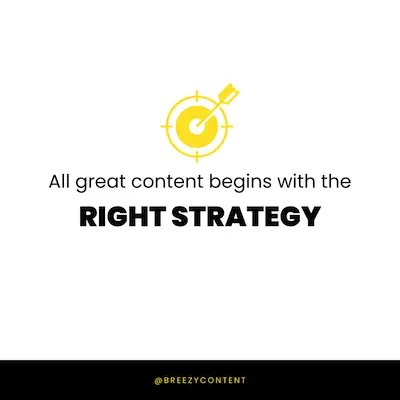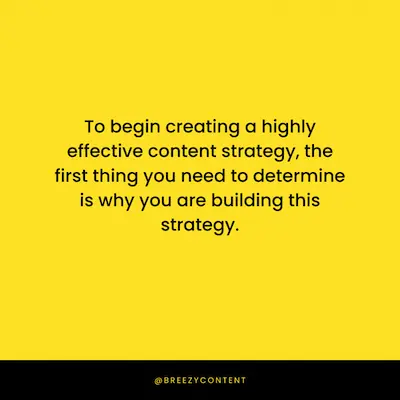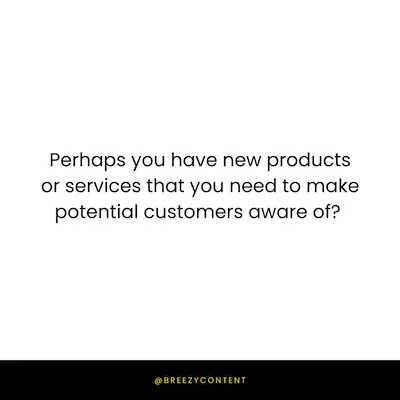
A content marketing strategy is the key to building strong brand recognition, awareness, establishing credibility and showing authority in your industry. If you start publishing content on social media or your blog without creating a well thought out strategy, you may occasionally get some things right, but you’ll also miss many opportunities to boost your business and expand your reach.
Are you looking to increase sales? Boost web traffic? Build credibility? Spread brand awareness? Perhaps you have new products or services that you need to make potential customers aware of?



Once you’ve identified the goal for designing your content marketing strategy, you should focus on what you’re trying to accomplish and how content marketing can help you get there. Make this as specific as possible. It might seem like this is the same as the previous question that you asked yourself, but it’s important to note that it is actually slightly different.
For instance, you might realize that a new content strategy is in order because sales need a boost. However, what you are hoping to get out of by creating a new approach to your content marketing may not be as broad as more purchases and profits. Instead, you might narrow it down to increasing customer engagement, newsletter sign-ups, web traffic, etc. All of which are things that can long-term lead to higher sales, but are easier and more attainable first steps.
There are actually a few different types of research that you’ll need to conduct. However, to start, you’ll want to look inwards and investigate your own business.
The research that you do here will help you understand your target demographic and guide the approach you take with your content marketing strategy.
A StoryBrand script is a great way to kick off this research into your own brand. You can start by creating a character that represents your customer base. This is going to be your customer persona or avatar. Think about who you’re trying to reach and make sure that they’re also part of an audience that would be interested in your products or services.
It’s important to note that while your strategy will help you boost your brand’s appeal to certain populations, you still shouldn’t be targeting people who have no need for your offerings at all. If you do that, you’re focusing on the wrong demographic and even the best marketing strategy might fall flat. Instead, think about people who are already inclined to buy what you’re selling, but just might need a little push.
Once you know who you’re dealing with, think about what brings them to your business. What problem are they looking to solve? Knowing their pain points is essential knowledge to have before you can demonstrate your brand’s value. If you don’t know what is wrong, how can you claim to be able to fix it?
The StoryBrand script is going to take this information and guide you through potential outcomes. It will have you think about ways that you can approach their concerns, and the plan that subsequently comes together. You will also be prompted to consider both successful and unsuccessful results, so that you can prepare for both possibilities, and learn how to maximize the possibility of a conversion.
After you’ve completed the research that concerns your brand, you should start looking outwards. Look at the companies that are established and successful in your industry. If you analyze your competitor’s content, you will be able to guide your own content strategy.
For one, you can see what they are doing right. You don’t ever want to copy another brand entirely, but there are elements of success that you should emulate. For instance, if they get lots of engagement through creating specific styles of videos, as opposed to others, maybe that’s the format you should put most of your effort into as well.
This is also an opportunity to determine where you can stand out. There are probably opportunities that your competitors are missing. See if you can identify any of these. If you can notice ways in which their content could be improved, you can build strengths into your own strategy.
Next, you’ll want to do keyword research. This is going to help you word the content that you create. It will allow you to develop an understanding of the type of search queries your audience is actually making. If you know what things people are searching for, then you can target those keywords to help ensure that they find your brand.
Hashtag research is also going to be an important step. This is kind of like keywords but for social media. Hashtags allow people to search for topics and find posts that are similar to each other or relevant to the subject that they’ve searched for. People and brands can use hashtags to help make their posts more discoverable. Every time you tag a post, you’re increasing the likelihood that someone new will come across your account. Therefore, it’s important that you do research into popular hashtags, so you can optimize your posts accordingly.
Now you’ll want to establish the content “pillars” that are most important. These are the categories of content that you will be creating.
This is why your research is going to be so crucial. Keyword and Hashtag research will help you to understand what topics are popular, so you can create the kind of content that people are looking for. Likewise, research on your brand and your competitors is important because this can show you what kind of content is desirable, instead of just the subject matter of the content.
A content pillar is going to be more concerned with the latter two forms of research, because a pillar is the type of content you create, not what the content is about. However, all of the research you have conducted will play a key role. There are numerous types of content pillars that you can create. Some examples include: thought-leadership, direct sales, Q+A, inspiration, fun/engagement directed, and blog post promos.
You’ll want to plan your first month of categories just with categories only. From there, you can brainstorm 5-10 ideas for each of the categories as a jumping-off point. Ultimately, you’ll just decide to use 1 of these ideas per each pillar category you have.
Once you’ve made it this far, you’re ready to start drafting actual content.
It’s important to take the previous steps to make sure that the content you create is strong and that it will be relevant and useful to your audience, as well as likely to drive conversions. You don’t want to rush the buildup, because you can ultimately waste a lot of time creating the wrong content.
However, if you’ve taken the previous steps, you’re probably ready for sample-building. From here, you’ll want to start with copy. This is the writing and wording behind the content you create. Focus on things like tweets or the written component of Facebook and Instagram posts, as well as blog articles, and text that is designed to generate leads. There are lots of other types of copy you can write as well, but these are a few ideas to get the ball rolling.
Once you have the words ready, you can focus on making it look nice; visuals are the next step. Depending on what type of content you’ve created, you might create graphics, edit photos, or compile video footage.
Finally, you’ll want to take all of the sample content you’ve created and lay it out. Make any and all necessary adjustments and edits to ensure that it flows together and is as strong as possible. Once you’ve finished tweaking, you can finalize it!
From here, congratulations are in order – you’ve built a content strategy. You are able to start posting now!
Just be sure that you keep this same strategy and approach for at least 3 months. You’ll want to measure it against your SMART goals monthly, and then you can reevaluate to see if the pillars, methods, types of content, media, etc. need to be updated or changed to better provide value for your audience.
You don’t want to continue with elements of your strategy that are ineffective. It’s a waste of time and resources that you could dedicate to creating content that does build your brand more reliably. However, it’s also important to acknowledge your successes as much as your failures. Make sure that you recognize what IS working as well as what is not, so that you can replicate and repeat the things your strategy has gotten right.
That’s why we built our Content Machine here at Breezy to make content marketing simple and easy. Learn more about our process in this video below or schedule a free consultation to get started!
Savannah Abney is the Co-Founder and CEO of The Breezy Company. With over 6 years of experience, she specializes in content strategy, video marketing, and brand storytelling-helping small businesses grow through a strong digital reputation.
Read more articles by Savannah Abney
